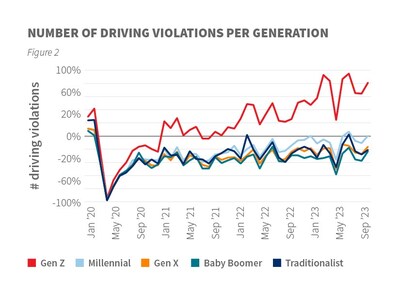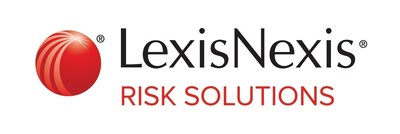U.S. Auto Insurance Trends Report Highlights New Generational Risks in Drivers and Vehicles that Continue to Contribute to Higher Claim Frequencies
LexisNexis Risk Solutions released its 2024 U.S. Auto Insurance Trends Report, highlighting significant shifts in driving behaviors, insurance shopping trends, and claim dynamics. Key findings include a 24% increase in distracted driving violations among Gen Z from 2022, and a 66% rise since 2019. Claim severities are high due to parts and labor shortages, and attorney involvement. Insurers raised rates by 14% in 2023, improving the combined loss ratio to 105%, but consumer retention has dropped from 83% to 80%. EV claims are more frequent and severe compared to traditional vehicles. The report underscores the need for insurers to balance market acquisition with rate adequacy to maintain profitability.
- Insurers raised rates by 14% in 2023, leading to a 7-point improvement in the combined loss ratio to 105%.
- New auto insurance policies increased by 6.2% in 2023.
- EV sales grew 54% in 2023, with EVs insured growing by 40% to 3.9 million.
- Major speeding violations increased by 10% from 2022 to 2023, indicating higher enforcement or reporting.
- Distracted driving violations among Gen Z rose by 24% from 2022 and 66% since 2019.
- Claim severities remain high due to parts and labor shortages and attorney involvement.
- Consumer retention dropped from 83% to 80% in 2023.
- Claim severity for EVs was 34% higher than traditional vehicles, and claim frequency was 17% higher.
- Bodily injury claim severity has increased by 20% since 2020, and material damage severity by 47%.
Insights
The insights provided in the LexisNexis® U.S. Auto Insurance Trends Report suggest significant challenges and opportunities for auto insurers. The 14% year-over-year rate increase in 2023, which resulted in an improvement of the combined loss ratio from 112% to 105%, indicates a trend towards profitability. However, the persistent high claim severities, influenced by parts and labor shortages and increased attorney involvement, present ongoing cost pressures. The increase in policy shopping and switching levels also demonstrates consumers' price sensitivity, which can lead to higher churn rates for insurers.
Insurers need to focus on optimizing their underwriting strategies to manage risk more effectively, particularly as new risk segments such as EVs pose unique challenges. The data highlights the need to balance market acquisition efforts with customer retention strategies to mitigate the impacts of rate increases on policyholder loyalty. In the short term, insurers may need to continue adjusting rates to cover rising costs, but they must also invest in customer satisfaction and claims handling improvements to maintain competitive advantage in the longer term.
The report emphasizes shifting market dynamics, notably the growth in electric vehicle (EV) sales and their impact on claim frequency and severity. With EV claims being 17% more frequent and 34% more severe than those for internal combustion engine vehicles, insurers must adapt their risk assessment models to account for these differences. The significant increase in distracted driving violations among Gen Z drivers, up 24% from 2022 and 66% since 2019, highlights the evolving risk profiles that insurers must contend with.
For stakeholders, these trends suggest a need for more sophisticated data analytics and targeted risk management strategies. Insurance companies that can leverage data-driven insights to refine their pricing and underwriting practices will be better positioned to manage emerging risks and maintain profitability. Additionally, the rise in consumer dissatisfaction with the claims process underscores the importance of improving operational efficiencies and customer service to enhance policyholder retention.
From an industry perspective, the report underscores several critical areas of concern and opportunity for U.S. auto insurers. The increase in distracted driving and speeding violations, particularly among younger drivers, aligns with broader trends towards riskier driving behavior. Furthermore, the complexities associated with EV claims necessitate updates to coverage policies and repair protocols. The heightened involvement of attorneys in claims processes, with 93% of claimants likely to retain legal services in future claims, suggests that insurers may face continued upward pressure on settlement costs and timelines.
Insurers must balance short-term measures such as rate increases with long-term strategies aimed at improving customer satisfaction and streamlining claims processes. Enhancing consumer engagement and transparency in the claims experience can help address the frustration expressed by nearly half of auto insurance consumers. Moreover, the report’s findings indicate a need for insurers to be proactive in adapting to generational shifts and technological advancements to maintain competitive positioning and mitigate emerging risks.
2024 LexisNexis®
Key takeaways
- Risky driving behavior rises among younger demographics as distracted driving violations by Gen Z increased
24% from 2022 and a staggering66% in comparison to 2019. - High claim severities persist due to parts and labor shortages along with rising attorney involvement, with
93% of claimants who sought legal counsel likely to retain services in the future. - Consumer dissatisfaction around total loss remains high, as roughly half (
46% ) of auto insurance consumers note frustration with a lengthy claims process. - Auto insurers are taking an aggressive approach to profitability challenges with an unprecedented
14% year-over-year rate increase in 2023, improving the combined loss ratio to 105i%, a 7-point improvement over112% ii in 2022. - Consumers are responding in a big way as elevated rate increases have led to record auto insurance policy shopping and switching levels, with new policies increasing by
6.2% in 2023. Consumer retention rates dropped from83% to80% , indicating there may be a need for insurers to focus on their existing portfolios and take steps to update their underwriting practices over the course of 2024. - Differing driving experiences in electric vehicles (EVs) have contributed to higher and more severe claims than internal combustion engine (ICE) vehicles. In 2023, claim frequency and severity for EVs were
17% and34% higher, respectively, than traditional segments.
"Auto insurers are navigating a dynamic and challenging market environment in 2024. For their part, consumers are displaying more unpredictable driving and policy shopping behavior, and increasingly switching carriers to find better rates," said Adam Pichon, senior vice president of global analytics, insurance, LexisNexis Risk Solutions. "It is crucial for insurers to balance market acquisition and retention with rate adequacy and utilize data-driven insights to help manage risk and maintain profitability to be set up for continued success as the market begins to soften."
Gen Z drivers and EV technology bring newfound risk
- Both major speeding violations (up
10% from 2022-2023, up36% since 2019) and minor speeding violations (up16% from 2022-2023, up15% since 2019) continue to increase. - Distracted driving is more prevalent among younger drivers, especially Gen Z. From 2022-2023, violations for the age group increased by
24% and, compared to 2019 figures, have risen66% . - Distracted driving across all age demographics rose
10% from 2022-2023. - In 2023, EV sales grew
54% compared to Light Duty Vehicles (LDVs) sales growth of13% iii. The total number of EVs insured grew by40% to 3.9 million in 2023, while the number of private passenger vehicles (PPAs) insured grew by only1.2% in the same period, to a total of 265 million. - Regarding consumer EV shopping behavior,
24% of new EV buyers shopped around for lower rates on their auto insurance policies in 2023, significantly higher than the19% of new PPA buyers that shopped for coverage last year.
Claim severity and complexity continue to rise
- Claim severity continues to challenge the insurance industry as claims severities have steadily trended upward since the pandemic. Compared to 2020, bodily injury has risen by
20% , along with severity as material damage has increased by47% . - Attorney involvement has helped contribute to the rise in claims costs. Over half (
51% ) of claimants who hired an attorney received a higher settlement amount. This activity is most prevalent following an auto accident, as85% of claimants were approached by one attorney and60% by more than one. - The time required to settle a claim is the highest determinant of customer satisfaction, followed by the number of people and touches needed to resolve the claim.
- In 2023, over a quarter (
27% ) of collision claims were deemed total losses, requiring payouts and consumers to replace a vehicle or find alternate transportation.
Profitability remains a challenge against heightened shopping activity
- Despite overall combined ratio improvements in 2023, insurers are still working towards profitability in many states with additional rate increases being enacted across the country.
- In response to the record-setting rate increases (
9% increase in 2022 and14% in 2023), traditionally stable consumers have taken to the market to shop their coverage. Among consumers who had auto insurance at the end of 2023,41% shopped at least once for a new policy. Overall, shopping increased4.7% in 2023, with many consumers switching carriers, driving new policies up6.2% in the same period. - Over 2022-2023, the number of drivers within a policy increased by
5% , pointing to changing risk profiles that may be overlooked during renewal periods and potentially indicating consolidation in households.
Download the 2024 LexisNexis Risk Solutions Auto Insurance Trends Report.
About LexisNexis Risk Solutions
LexisNexis® Risk Solutions harnesses the power of data, sophisticated analytics platforms and technology solutions to provide insights that help businesses across multiple industries and governmental entities reduce risk and improve decisions to benefit people around the globe. Headquartered in metro Atlanta,
Media Contacts:
Chas Strong
LexisNexis Risk Solutions
Phone: +1.706.714.7083
Charles.Strong@lexisnexisrisk.com
i Copyright @2024, S&P Global Market Intelligence (and its affiliates, as applicable)
ii LexisNexis Risk Solutions Internal Analysis
iii Argonne National Laboratory
![]() View original content to download multimedia:https://www.prnewswire.com/news-releases/us-auto-insurance-trends-report-highlights-new-generational-risks-in-drivers-and-vehicles-that-continue-to-contribute-to-higher-claim-frequencies-302177930.html
View original content to download multimedia:https://www.prnewswire.com/news-releases/us-auto-insurance-trends-report-highlights-new-generational-risks-in-drivers-and-vehicles-that-continue-to-contribute-to-higher-claim-frequencies-302177930.html
SOURCE LexisNexis Risk Solutions
FAQ
What are the key findings of the 2024 U.S. Auto Insurance Trends Report?
How have auto insurance rates changed in 2023 according to the LexisNexis report?
What impact do electric vehicles (EVs) have on auto insurance claims?
How has consumer auto insurance shopping behavior changed in 2023?









